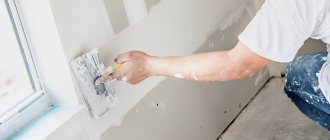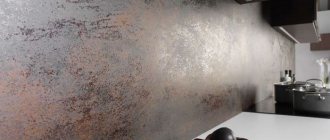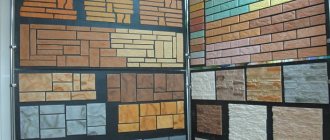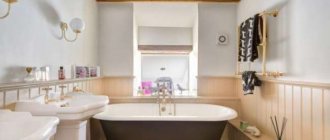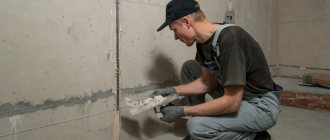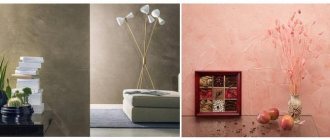11832 0 11
Zanoza November 2, 2016Blonde with head and arms
Plaster – sometimes you can’t live without it!
This is probably one of the most popular questions regarding finishing: which is better, plaster or drywall for walls? Each of these materials deserves attention, and each of them has its own characteristics.
Plaster is one of the oldest finishing materials, known since ancient times. It is practically a “classic” in the construction world, and is still popular today. Therefore, we can safely say that such finishing is very relevant.
Surface plastering process
Drywall appeared not so long ago, but quickly won a large “army” of fans. It is easy to use, does its job well, and generally adds new possibilities for finishing. Thanks to these features, it became a worthy competitor to plaster, but could not displace it from the construction market.
Drywall sheets.
So what is the main difference between them? What are the disadvantages and what are the advantages of the materials? Is it possible to choose the ideal option for the wall according to price and quality? You will find answers to all these questions in this article.
Comparison table between plaster and plasterboard wall finishing
| Plaster | Drywall | |||||||
| Finishing speed | Requires a long drying period. | Ready for finishing immediately after installation. | ||||||
| Complexity of finishing work | Some experience in carrying out the work is required; the room will be dirty and dusty. | Enough basic skills allow you to keep the room dry and relatively clean. | ||||||
| Price | If you prepare the plaster mixture yourself and carry out the work, the finishing will be cheaper. | May be more expensive than plaster. | ||||||
| At what curvature of the base should it be used? | Can be used with differences of up to 2 - 2.5 cm. | Can be used for strong differences reaching 4 cm or more. | ||||||
| Practicality | More practical, strong surface, easy to repair, allows you to hang heavy objects. | Less practical, fragile material, does not allow hanging heavy objects. | ||||||
| Preservation of interior space | Minimal area loss. | You can lose 4 cm or more on each wall. | ||||||
| Hiding communications | You can hide only the electrical wiring. | Allows you to hide pipes, installations and other elements. | ||||||
| Aesthetics of the finished surface | When the work is done well, it is perfectly level. | When the work is done well, it is perfectly level. | ||||||
Speed of construction and readiness for further finishing
One of the important differences in working with plaster and plasterboard is the time frame for completing the work. The speed of wall finishing in this case depends both on the characteristics of preparing surfaces for application or installation of the material, and on its properties.
Wall covering with plasterboard is carried out in several stages:
- fastening guide profiles using a hammer drill, screwdriver and self-tapping screws;
- installation of rack profiles;
- processing the edges of plasterboard sheets for joining;
- alternate installation of gypsum boards (the sheet is laid on 3 adjacent profiles so that the edge of the sheet falls in the middle of the outermost profile);
- fastening drywall sheets using self-tapping screws;
- sealing joints (putty solution – reinforcing tape – putty);
- covering the gypsum plasterboard surface with a thin layer of putty.
Preparing lathing from profiles for installing drywall for a room of 10 m2 along with processing gypsum plasterboard can take a maximum of a day. Installing sheets and sealing seams - about the same. Immediately after leveling the walls, you can begin to putty, and then paint, wallpaper, or apply other decorative coatings.
When leveling walls with cement-sand plaster, the procedure is as follows:
- removing from the walls the remains of old coatings (paint, wallpaper, decorative plaster), old screws and other metal elements;
- applying markings for beacons on the walls (in some cases, plastering is carried out without them);
- installation of beacons;
- applying the solution and leveling;
- drying the coating;
- removing beacons and sealing grooves;
- applying finishing putty.
One of the longest stages of plastering is the drying period. Applying putty and decorative coatings is possible only on a dry surface, otherwise the risk of cracks and peeling of the plaster is extremely high. Drying time depends on the humidity and temperature in the room and averages about a week or more.
In the case when finishing work needs to be completed as soon as possible, the answer to the question of which is better - drywall or plaster walls - is quite obvious. Under other favorable conditions, gypsum board becomes the best option.
Types of plaster
Plastered walls and ceilings are an ideal base for painting or wallpapering. Types of plaster for leveling surfaces:
- The most economical option is a cement mixture, which provides a durable coating with high heat and sound insulation and fire protection characteristics. The composition can withstand high levels of humidity, but is heavy, which makes it difficult to apply to walls and especially ceilings. It requires puttying and sanding before painting or laying tiles, but if properly leveled it can last a very long time.
- Cement-lime plaster has antibacterial properties, protecting the room from the appearance of mold and microorganisms.
- Gypsum is a dry mixture consisting of gypsum powder with plasticizers. Gypsum plaster is plastic, vapor-permeable, environmentally friendly, lightweight compared to cement, compatible with concrete and brick surfaces, and does not require putty before painting or wallpapering.
- Decorative plaster - can be silicone, mineral, silicate, used for finishing, allows you to create unusual and unique surfaces. It makes no sense to compare such exclusive types of this material as travertino, Venetian, Moroccan plaster with plasterboard, since their cost significantly exceeds the most expensive types of gypsum plasterboard along with finishing.
USEFUL INFORMATION: Drywall guide: how to attach, dimensions and prices
Difficulty in finishing work
Leveling walls using drywall requires not only certain materials and fasteners (gypsum plasterboard of a certain type, profile, self-tapping screws), but also high-quality tools, including a level (bubble or laser), hammer drill, screwdriver, plaster saw, metal scissors for cutting the profile, knife, hammer and pliers.
Measuring and setting the level, attaching lathing and drywall sheets - this requires care and basic skills and knowledge, which even non-professionals in the field of finishing often possess. Those who want to prepare the walls themselves without the help of specialists tend to choose gypsum plasterboard.
On a note! If the wall has slight deviations from the level, some craftsmen allow the installation of plasterboard sheets without sheathing. This method of finishing is only possible on a solid base in rooms where it is warm and dry all year round.
Working with plaster requires a larger amount of materials. In addition to cement-sand mortar or ready-made plaster mixture, compositions for primer and finishing putty are also required. The list of tools is also wide - from beacons and hammer drills, to trowels and rules. At the same time, it is extremely important to have certain skills in working with building mixtures and to have a good feel for the material - only in this case can you achieve a perfectly smooth surface, optimal for any decorative coating.
Comfort when working with materials is also important. Sheathing with plasterboard belongs to the so-called “dry method” - its use allows you to keep the room dry and clean.
When using plaster, dust and dirt can cause inconvenience already at the stage of preparing the solution, and therefore, when choosing this option, it is recommended to protect surrounding objects and the floor covering.
When deciding what is better - to plaster the walls or cover them with plasterboard - amateurs and those who want to do the repairs themselves in most cases prefer plasterboard, since working with plasterboard is much easier. Finishing specialists approach the issue more rationally and take into account other factors, which we will discuss later.
Reasonable savings: plaster or drywall - which is cheaper
The average cost of one sheet of drywall today is about 350 rubles. However, in addition to the gypsum board itself, the costs will include the cost of a steel profile, screws, dowels, hangers, and ultimately, simple and quick finishing of walls with plasterboard will cost a substantial amount.
Purchases of materials for plastering also include the cost of the building mixture itself, primer, finishing putty, beacons. But in the case of plaster, there is a way to save money if you do not buy cement-lime plaster mixture in bags, but make it yourself.
To make the plaster mixture you will need:
Quicklime construction lime.
Portland cement.
Fine sand for plaster mortars.
True, in this case, it is necessary to provide a place where all these components are mixed and take into account that this will require additional labor costs.
With smooth walls, the use of plaster turns out to be approximately 1.5 - 2 times cheaper than gypsum plasterboard, but if the curvature of the walls is significant, the costs of plastering can seriously increase. And if you also use the services of specialists, then the difference in the cost of using gypsum plasterboard and building mixture will be smoothed out almost completely.
What is better to use for a very crooked base?
Regardless of the material from which the walls are made - brick, slabs or foam concrete - they do not always have a perfectly flat surface. That is why, before choosing finishing methods, it is extremely important to examine the walls for the presence of local irregularities and general curvature as a whole.
If the base deviates by up to 2 - 2.5 centimeters, it is possible to level the wall with plaster - such a layer allows you to hide differences without wasting time and material. In this case, it is necessary to understand one point regarding the thickness of the plaster. There is a misconception that the plaster layer should be 2 cm thick.
In fact, this is the average thickness of the plaster layer. In those places of the wall where there are bulges, the thickness of the plaster is less. In these zones it can even reach 3-5 mm. Moreover, if there is a depression on the wall, then in this place the thickness can reach 3 cm. That is why, if there is a deviation of 2 cm, you do not have to apply a layer of 4 cm to level the wall. If there is a strong bulge on the wall that cannot be hidden with a layer of plaster, it can be trimmed off.
Average thickness of the plaster layer.
However, if the deviation exceeds 4 centimeters or the number of local irregularities is too large, it is much more rational to make a choice in favor of drywall. In this case, to get rid of the curvature, it is enough to correctly align the frame, and the costs for the material, in this case, will be approximately the same.
How to choose which is better?
If the financial aspect is most important, then it is better to decide to decorate the walls with sheets of plasterboard glued to the wall. However, if we want to get a more durable and reliable coating, then traditional plaster is recommended. Here we have a fairly wide selection:
- gypsum plaster;
- clay;
- limestone;
- cement;
- their combinations and some other modern technologies.
Both types of coating then need to be puttyed and carefully sanded to a completely smooth surface before we paint or wallpaper them.
Gypsum boards are a less demanding material to install than plaster, so we can, if we have certain skills, decorate the walls with them ourselves. For plastering work you need to have some experience; this is a more labor-intensive technology. An interesting alternative is machine plastering, which allows you to quickly and efficiently complete a large amount of work.
In terms of speed of work, drywall is better than plaster, as it allows you to complete repairs faster. It should be remembered that when plastering, we must wait before painting, usually 2-3 weeks. This problem does not occur with drywall, which can be painted much more quickly.
What is more practical in operation: drywall or plaster?
If you work with plaster competently and strictly follow the application technology, the practicality of the material can be much higher. The plaster can withstand any changes in temperature and humidity, is highly durable and allows the attachment of any wall decor, shelves and other hanging structures.
From this point of view, gypsum plasterboard demonstrates slightly less reliability and greater fragility. It is highly not recommended to attach heavy interior items to a wall finished with plasterboard. In addition, the material is sensitive to high humidity, cold and sudden changes in temperature, so its use for finishing walls in country houses where people do not live permanently is strictly not allowed.
There is one more unpleasant moment that may “pop up” during the operation of drywall. Between the sheet of drywall and the load-bearing wall there is always a space that can attract all kinds of insects and rodents.
In this regard, plaster is far ahead. It is strong, does not break, and can be easily repaired if necessary.
Disadvantages of drywall
Among the disadvantages of gypsum boards:
- fragility of the erected structure;
- reduction of room area;
- the need to completely replace drywall in cases of flooding from the upper floors;
- difficulties with placing heavy objects on the walls, special fasteners are required, and in order to hang heavy cabinets on drywall in the kitchen, you will have to think about ways to strengthen it.
Leveling walls with plasterboard requires a whole range of work. To create an ideal surface, you will need to seal the seams and the locations of the screws with putty, apply a layer of primer and then putty to the entire surface of the drywall, and after drying, sand it. When everything is dry, you can begin wallpapering, painting or finishing with decorative plaster.
What is best to use to preserve interior space in a room?
Depending on the quality of the surface, the thickness of the plaster layer, as a rule, does not exceed a few centimeters. Even if all the walls in the room are finished with plaster, the loss of area will be minimal.
With drywall everything is a little more complicated. The thickness of the plasterboard sheet for walls is 10 - 12.5 mm. If we add here the thickness of the sheathing, it turns out that the entire structure with gypsum plasterboard hides at least 4 centimeters along one wall.
If you plan to cover the surface with tiles, then there is a risk of losing about 5 - 5.5 centimeters - in the end the room will be about 10 centimeters narrower and just as shorter. That is why it is worth using plasterboard sheets in small rooms, where every square centimeter is priceless, only if there are no other finishing options. First of all, this concerns bathrooms, which in many apartments are not large anyway.
Which material hides communications better?
It is possible to hide electrical wiring in plastered walls. Especially for this, grooves are made in the right places, where the wiring is laid. In this case, plaster allows you to hide everything unnecessary and achieve a smooth surface.
However, when it comes to plumbing, it becomes obvious that no building mixture is capable of hiding risers and pipes brought outside. In this case, gypsum boards will come to the rescue, which involve various options for masking communications - erecting a fragment of a false wall, solid cladding of a corner, or constructing a decorative box with an inspection hatch.
Attention: For bathrooms, as well as for other rooms with high humidity, it is recommended to use only moisture-resistant drywall with gypsum board masking!
Aesthetics of the finished surface
Whether to give preference to modern finishing mixtures or use drywall instead of plaster - the pros and cons of each decision must be carefully weighed. At the same time, the final finishing result is far from minimally important.
With proper installation of gypsum boards, you can get a smooth surface with minimal effort. After installing the sheets, a thin layer of putty is applied to the drywall, which makes the surface perfectly smooth. Working with plaster requires greater care - however, with precise adherence to technology and a certain level of skill, the surface turns out to be impeccably smooth and uniform.
Thus, both materials allow you to achieve the desired result. However, drywall may require minor modifications, and plaster may require some effort at the finishing stage. The choice depends on the condition of the room and the preferences of the home owners.
Pros and cons of materials
There are no perfectly straight walls. Painting or wallpapering them will not hide them, but, on the contrary, will highlight all the imperfections more clearly. Therefore, when finishing an apartment (private house), it is always necessary to level the walls.
For these purposes, two completely different technological solutions are used:
- drywall;
- plaster.
Each has its own advantages and disadvantages. To make a final decision, you need to learn more about them.
Drywall
The most popular building material, the leader in sales in the USA and Europe, plasterboard, is rapidly gaining ground over plaster in Russia. Real professionals can use this material to greatly diversify the interior of a room, which cannot be done with plastering work in principle.
Drywall consists of a layer of gypsum covered on both sides with cardboard. Its abbreviation is GKL (not to be confused with gypsum-fiber sheets GVL, where the strength of the sheet is achieved by fibers mixed with gypsum, rather than cardboard). Professional work during its installation ensures a perfectly flat surface of the walls.
If you use drywall instead of plaster: the pros and cons of this technological solution are below.
- Allows you to implement any design solutions - it bends perfectly, as a result of which you can create various decorative elements.
- Allows you to hide significant curvature of walls (more than 4 cm) both horizontally and vertically, as well as their defects - chips and peeling.
- Serves as an additional, and this good, sound and heat insulating layer.
- Ideally hides utility lines.
- Installation work is completed quickly.
- No experience or qualifications are required for installation - basic concepts are sufficient. This results in significant savings - the cladding can be done by hand.
- The material is environmentally friendly.
- Further finishing work can be carried out immediately after attaching to the wall.
- There is no dirt during work - plasterboard sheets: cut with a construction knife practically without debris and dust; They are attached to the wall or with self-tapping screws on a metal sheathing, or they are mounted with glue.
- It hides mortar or adhesive seams of walls well if aerated concrete, foam blocks or gas silicate were used for their construction.
- Allows walls to “breathe” - gypsum plasterboard reacts very quickly to changes in humidity. When it increases, it quickly takes moisture from the air, and also quickly releases it when it decreases.
- Indispensable when eliminating inconsistencies between walls and FBS (foundation building blocks), when the blocks protrude into the building by more than 4 cm.
With so many advantages, this material also has disadvantages. Cons of drywall:
- It greatly “steals” the volume of the room, especially when attaching gypsum boards to the sheathing;
- Low strength - cannot withstand a medium-sized painting, let alone heavier objects. Experienced craftsmen solve this problem simply. At the place where heavy objects are fastened, a rectangle is cut out and plywood, or even better, OSB sheets, is attached in place of the gypsum board. Therefore, this disadvantage is rather relative;
- A categorical ban on use in homes with temperature changes down to sub-zero values. In country houses, or rather dachas, where there is no constant heating in winter, it is destroyed;
- Finishing wallpaper requires applying a thin layer of putty. If you glue wallpaper directly onto drywall, then when you replace it, which is done after about 7-8 years of operation, you will also have to change the gypsum board - when removing the wallpaper, the cardboard will be torn off from the plaster, which leads to inevitable destruction of its layer;
- Promotes the appearance of rodents in the apartment - mice live in the space between the wall and the drywall;
- The bathroom sharply, up to 7 years, reduces the service life of gypsum plasterboards, even if special moisture-resistant types (gypsum plasterboards) are used. They can be easily distinguished on sale by their green color with blue inscriptions.
When to use plaster and when is plasterboard preferable?
As is the case with any building materials, it is impossible to say for sure whether it is better to level the walls with plasterboard or plaster. It all depends on a number of external factors - including the condition of the object, climatic and temperature conditions, the curvature of the walls, the planned decorative finishing and the personal preferences of the object owners and specialists.
So, you should give preference to plaster if:
#1.
Requires finishing of a room with an unstable microclimate.
#2.
It is necessary to save as much space in the room as possible.
#3.
The curvature of the walls does not exceed 2 - 2.5 centimeters, and the presence of dirt and dust during the finishing process is not critical.
#4.
Cost savings are necessary when doing the work and preparing the mixture yourself.
#5.
Heavy wall structures are expected to be mounted in the room.
#6.
It was decided to involve specialists in the finishing work.
Leveling with putty
When to use putty
Putty is a mixture for leveling walls and sealing cracks, seams, and gaps. The solid particles in putty are smaller than in plaster, so the surface is smoother. Putties are produced in dry and ready-to-use forms. Ready-made putties are more expensive.
Putties are divided into starting, finishing and universal. The particles in the starting ones are larger than in the finishing and universal ones. These are the cheapest putties. They are used when it is necessary to eliminate wall defects up to 5 cm deep.
Wall leveled with starting putty
, rough to the touch.
If the wall is being prepared for painting, a layer of finishing putty
0.1 - 0.2 cm thick is applied on top. The filler particles in it are smaller than in the starting one, so the surface is smoother.
In universal putties
the grains are as small as in the finishing ones. But due to additives, they are only slightly inferior in strength to starting mixtures. Universal putties are used for starting and finishing work.
Universal cement putty Osnovit Bassilk PC30 MW 20 kg, layer up to 10 mm - 314 rubles, Virashop online store. Mixture consumption 1 kg/m2 with a layer of 0.1 cm.
Putties are made based on cement, gypsum or polymers. Cement putties are applied to concrete, brick, cement, and wooden walls. Produced in dry form, packaged in bags of 25 - 30 kg.
Cement mixtures
They are not afraid of moisture, temperature changes, and do not peel off if the room freezes. They are used for any premises, including kitchens, bathrooms, and unheated corridors. However, these mixtures shrink and crack when dry. Increase plasticity using various additives. Cement putties dry for up to 2 days.
Starting cement putty Forus K, 20 kg, layer up to 5 mm - 380 rubles, group store. Consumption 1.0-1.1 kg/m2 with a layer thickness of 0.1 cm.
Gypsum putties
give a smooth surface that does not require sanding. They are laid on any base. They do not shrink and dry in 2–6 hours. But they are not as durable as cement ones and absorb moisture. The wet layer falls off. In bathrooms, gypsum putty is installed provided that the hood works well there.
Putty “Starateli”, gypsum, 20 kg, finishing, layer thickness up to 10 mm - 320.66 rubles, StroyGarantServis online store. Consumption 0.9 kg/m2 with a layer thickness of 0.1 cm.
Polymer putties
much more expensive than cement and gypsum. They are applied in a layer of 1 - 2 mm as a finishing coating.
Teknos Ahrweicryl Feinspachtel Rapid putty, acrylic, 1.3 l - 1,530 rubles, Izolux hypermarket.
Polymer putties provide a smooth surface that does not require sanding. Waterproof compounds are used for finishing facades.
How to save money
The consumption of starting cement putty is 1.0 – 1.8 kg/m2 with a layer thickness of 1 mm. For a wall with an area of 15 m2 with a layer thickness of 10 mm and a consumption of 1.0 kg/m2 per millimeter of layer, 150 kg of mixture will be needed. Universal mixtures are consumed like starting mixtures - about 1 kg per m2 with a layer thickness of 0.1 cm.
The finishing mixtures are applied in a layer of 0.1 - 0.2 cm. The average consumption is 0.05 - 1.0 kg/m2. A 15-meter wall will require 15 kg.
Recommendations for saving are as follows:
- do not use putty to fill irregularities more than 5 cm deep - for such defects, plaster will cost less and the layer will be stronger;
- do not use finishing mixtures to eliminate irregularities deeper than 0.2 cm - it will be expensive. It is more profitable to put the starting mixture and the finishing mixture on top of it.
Other ways to save are the same as for plastering work: choose the right putty, correctly calculate the quantity, turn to experienced craftsmen.



